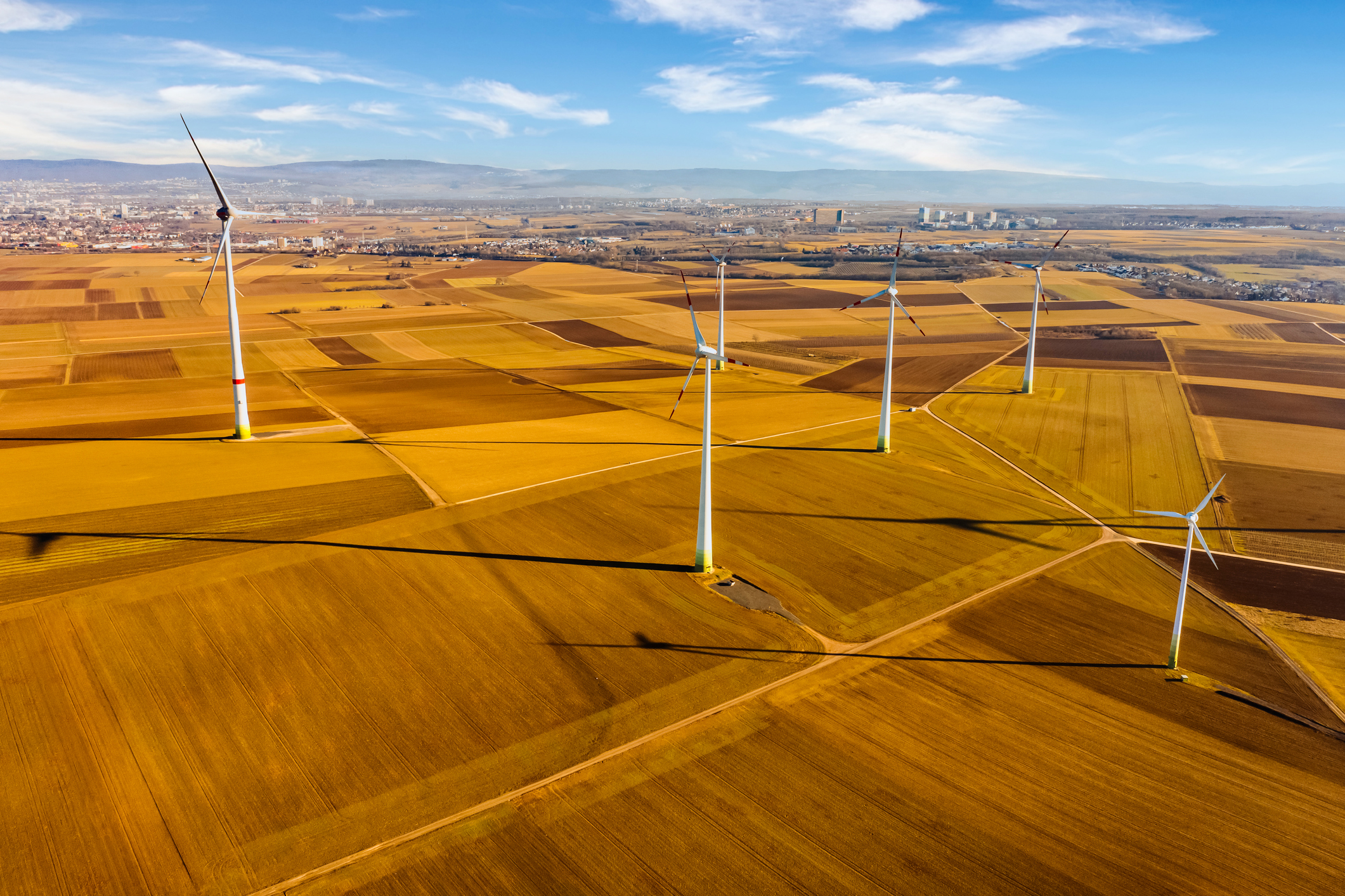To better understand what will be required of leaders in the sector over the next five years, IQ presents the top five disruptive forces and critical success factors for the energy industry, featuring insights from industry executives Chuck Woodside, CEO of KAAPA Ethanol Holdings, and Charlie Bayless, board member of TS Conductor and E Source, and former chairman, president, and CEO of Tucson Electric Power and Illinova.
According to projections from the International Energy Agency, the global energy revolution is kicking into overdrive, and by 2030, the landscape could look dramatically different.
Imagine a world where ten times as many EVs are zipping around than today—and where solar power, not just a niche player, is generating more electricity than the entire U.S. grid currently does. Clean energy will be unstoppable, with renewables set to power nearly half of the world’s electricity. This isn’t just about solar and wind—massive investments in offshore wind are set to blow past those in fossil fuels, reshaping the global energy economy.
Yet, countries must first meet their energy and climate commitments in order to accelerate the industry further. Despite thrilling projections, stronger measures are still needed to keep global warming below 1.5°C.
Over the next five years, executive leaders will navigate decarbonization and decentralized energy production trends, as well as the rise of cyber threats and geopolitical turbulence. At the same time, new opportunities are emerging in areas like smart grids, artificial intelligence, and consumer engagement. Capitalizing on these challenges and opportunities necessitates that industry leaders identify key disruptive forces that will shape the future of their sectors.
Based on research and insights from global executives across the fast-moving energy industry, the top five disruptive forces are:
1. Decarbonization as a Reaction to Climate Change
With many countries and companies pledging to reach carbon neutrality by 2050, the demand for fossil fuels is projected to decline significantly, especially in oil and gas.
This shift toward decarbonization will require a complete overhaul of the current energy system, emphasizing the adoption of alternative energy sources such as green electricity, biofuels, and hydrogen.
One key factor driving this transformation is the relatively low barriers to entry for renewable energy generation compared to traditional fossil-fuel-based power plants.
The development of renewable energy technologies, combined with evolving regulations, is attracting new players to the market. Not only are smaller companies entering the space, but larger tech and telecommunications firms are also making strides to become key providers of home energy services.
Additionally, oil and gas giants are leveraging their financial strength to diversify their portfolios, despite the long-term decline of fossil fuels. These companies can continue profiting from their fossil fuel businesses while funding investments in renewable energy and other sectors.
New digital technologies, such as cloud computing, artificial intelligence, and robotic process automation, are playing a crucial role in accelerating decarbonization. These tools streamline operations, reduce emissions, and enhance efficiency across the energy sector. As a result, the transition to cleaner energy sources is expected to intensify, with competition heating up among both established energy companies and new market entrants.
2. Decentralization of Energy Production
Traditionally, energy grids have been centralized, operated by large monopolistic providers. However, a significant shift is underway toward distributed energy production, where individuals and businesses generate their own electricity through renewable energy sources and localized microgrids.
This rise of “prosumers”—households or businesses that both produce and consume energy—is largely driven by technologies like rooftop solar panels and electric vehicles. These distributed energy resources are enabling consumers to meet their own energy needs, blurring the lines between power generation and consumption. As more people become energy producers, the traditional utility model is being challenged.
The adoption of decentralized energy systems is made possible by advancements in connected technologies and the increasing integration of renewable energy, such as solar and wind, into the grid. These systems are more flexible and resilient, allowing for local energy generation and storage, which can help reduce reliance on large power plants and centralized grids. However, this shift presents new challenges for energy executives, as they must manage the transition from a centralized grid to a more complex, distributed energy landscape.
The growing number of prosumers requires a grid that can handle bidirectional energy flows, as well as the integration of new digital tools to manage these dynamic systems. This trend also increases competition as new entrants—both small and large players—tap into the decentralized energy market, further pressuring traditional energy providers to innovate.
3. Cyber Threats Are on the Rise
As energy infrastructure becomes increasingly digital, it is also more vulnerable to cyberattacks. This growing threat requires companies to significantly strengthen their cybersecurity measures to protect against emerging risks, especially as attacks on energy systems become more frequent and sophisticated. Energy executives are well aware that their industry is a prime target for cyber attackers, including nation-state actors seeking to disrupt essential services.
While many companies have made strides in digitizing their back-office functions like finance and accounting, their operational technologies—such as supervisory control and data acquisition systems (SCADA)—remain outdated and highly susceptible to attacks. These legacy systems, which are integral to managing industrial operations, were not designed with modern cybersecurity threats in mind, making them a significant liability. Moreover, the adoption of new technologies to increase connectivity between the field and centralized operations introduces additional risks.
Yet, as companies integrate more connected devices and sensors into their infrastructure, the potential for cyberattacks grows and creates more vulnerabilities, while also making security more complex.
4. A Lack of (Nuclear) Energy Independence
The U.S. nuclear power industry relies heavily on foreign sources for its uranium supply, raising significant risks to energy security and stability. In 2022, U.S. civilian nuclear reactors purchased approximately 40.5 million pounds of uranium—U3O8e equivalent—from both domestic and international suppliers, with the majority coming from foreign countries.
The breakdown of uranium supply sources highlights the U.S.’s dependence on external partners. Canada accounted for 27% of the uranium purchased, followed by Kazakhstan with 25%, Russia with 12%, and Uzbekistan with 11%. Smaller shares came from Australia (9%) and six other countries, contributing a combined 16%. This reliance on a diverse set of international suppliers exposes the U.S. nuclear energy sector to geopolitical risks and potential supply chain disruptions.
This dependence on foreign uranium suppliers is particularly concerning given the current global geopolitical tensions, especially with Russia. As one of the leading uranium providers, Russia’s involvement poses strategic risks, making it critical for U.S. energy leaders to reassess their supply chains. Additionally, uranium supply from other key players, such as Kazakhstan and Uzbekistan, may be affected by regional instability or shifts in their own energy strategies.

5. Geopolitical Turbulence Continues
Geopolitical turbulence remains one of the most critical challenges for energy industry leaders over the next five years, as international conflicts and political instability disrupt access to vital resources like oil, gas, and raw materials for energy production. These disruptions pose serious threats to the global energy supply chain, impacting not only traditional energy sources but also key industries like battery and solar panel production.
One key example is the conflict surrounding Nord Stream 2, a pipeline that once accounted for 35% of Europe’s natural gas supply from Russia. Escalating tensions between Russia and Europe drastically reduced the flow of gas, resulting in a sharp increase in gas prices across Europe. After leaks in the Nord Stream pipeline, gas prices surged by 19%, underscoring the volatility caused by geopolitical issues.
The closing of the Suez Canal due to conflicts in the Red Sea has also forced shipping companies to reroute, disrupting trade between Western nations and leading to a shift in economic power towards China and Russia. The Bab el-Mandeb Strait, a critical chokepoint for 12% of the world’s oil and 8% of liquefied natural gas trade, further complicates global energy logistics.
Another area of concern is China’s dominance in battery and solar panel production. In 2023, China invested over $130 billion in its solar industry, controlling more than 80% of the global supply chain for polysilicon, wafers, cells, and modules. Similarly, China holds over 80% of the world’s battery manufacturing capacity, though efforts in the U.S. and Europe aim to reduce this dominance by 2030. Despite these efforts, Chinese-made solar modules and batteries remain significantly cheaper than those produced elsewhere, making it difficult for other regions to compete.
Critical Success Factors
In a 1984 Sloan Management Review article titled, “An Assessment of Critical Success Factors,” A.C. Boynlon and R.W. Zmud wrote:
“Critical success factors [CSFs] are those few things that must go well to ensure success for a manager or an organization, and therefore, they represent those managerial or enterprise areas that must be given special and continual attention to bring about high performance. CSFs include issues vital to an organization’s current operating activities and to its future success.”
For energy executives and enterprises to survive—and thrive—over the next five years, capitalizing on the following critical success factors will be key:
Get Smart
The adoption of smart grids and digital technologies could be a crucial success factor for energy industry leaders over the next five years. These technologies significantly enhance grid reliability, lower operational costs, and improve customer service. Smart meters, AI-driven grid management, and IoT devices are revolutionizing the sector by enabling more efficient energy distribution and demand response systems. These innovations create opportunities for a more resilient and responsive energy grid, allowing utilities to better manage supply and demand fluctuations.
One emerging trend is offering energy solutions as a service (EaaS). This model provides energy management services, distributed energy resources (DERs), and microgrid solutions to commercial and industrial customers. EaaS helps customers reduce costs, improve sustainability, and increase energy resilience, making it an attractive option for businesses looking to optimize energy usage while minimizing environmental impact.
Additionally, Carbon Capture and Storage (CCS) technologies are becoming increasingly important in reducing emissions from fossil fuel-based power generation. By capturing and storing CO2 emissions, companies can continue using existing infrastructure while meeting stringent climate goals.
Embrace Artificial Intelligence and Machine Learning
Emerging technologies are revolutionizing operations, from enhancing cybersecurity to optimizing grid management and improving customer service. AI and ML can help predict maintenance needs for grid infrastructure, significantly boosting efficiency, resilience, and reliability in energy delivery.

Advancements in AI and ML are also expected to enhance renewable energy technologies and energy storage solutions. These improvements are vital for meeting growing electricity demand and will play a key role in expanding electric vehicle (EV) adoption by driving energy efficiency. As renewable energy becomes more cost-effective, it could enable EVs to reach price parity with traditional gasoline and diesel vehicles, further accelerating the shift toward greener transportation.
Executives are already investing in AI-driven solutions by securing financial incentives such as grants and tax credits that support the transition to renewable energy. They are also modernizing their technological infrastructure, with a focus on cloud computing, data analytics, and cybersecurity to future-proof their operations. Moreover, non-traditional players like Google and Amazon are entering the energy space, offering smart grid technologies and new ways for consumers to interact with energy data, such as through smart homes.
However, AI’s growing presence also raises concerns. A single AI query uses significantly more energy than a standard search, and the International Energy Agency (IEA) predicts that the energy demand of data centers powering AI will double by 2026, potentially reaching over 1,000 TWh—equivalent to Japan’s total electricity consumption. This rapid increase in energy use highlights the need for careful planning to prevent AI’s growing energy demands from straining the grid.
Face Regulatory Challenges Head-On
With increasing scrutiny on environmental, social, and governance (ESG) issues, particularly around greenhouse gas emissions reporting, energy companies must navigate a growing landscape of complex regulations. These regulations demand greater transparency, accountability, and adaptability from industry players.
The energy sector’s reliance on complex global supply chains makes it especially vulnerable to regulatory shifts. To comply with new mandates, companies need to improve supply chain transparency and resilience, often through advanced technologies like data analytics and cloud solutions. These tools enhance visibility and allow companies to better predict and respond to regulatory changes, ensuring smoother operations amid tightening requirements.
Executives are taking a proactive approach to stay ahead of these regulatory challenges. By engaging with regulators and forming alliances with tech firms and research institutions, they can co-create flexible yet robust compliance frameworks. Additionally, emerging technologies like AI and machine learning are being employed to offer deeper insights and foster more proactive compliance strategies.
The ongoing shift toward decarbonization is also reshaping financial incentives such as tax credits and government grants. Energy companies that have long invested in infrastructure now face the challenge of managing the costs of potentially obsolete machinery if the renewable energy transition succeeds. Leaders will need to find innovative financial strategies to relieve the burden of unproductive assets while aligning with sustainability goals.
Prioritize Talent
Companies are redefining their employee value propositions to attract and retain top talent, particularly as younger generations seek more meaningful work, strong values, and opportunities for career development.
With a significant portion of the energy workforce nearing retirement and the rapid advancement of required skill sets, companies are investing heavily in reskilling and upskilling initiatives. This investment is crucial as the industry continues its transformation towards more digitized and automated processes.
In addition to training, digital platforms are being leveraged to enhance recruitment, engagement, and career development processes. Companies are increasingly utilizing AI to identify skill gaps, personalize employee learning, and streamline talent management. Data analytics also plays a key role in understanding and addressing employee needs, ultimately improving retention strategies.
Don’t Lose Sight of the Consumer
Increasing demand for renewable energy will likely push utility and energy companies to invest more in sustainable energy projects and adopt environmentally responsible business practices. To meet this demand, companies are expanding their offerings by acquiring renewable energy firms or creating new products that align with sustainability goals.
Today’s consumers are increasingly focused on transparency regarding their energy consumption, costs, and sources. As a result, energy companies are responding by offering detailed consumption reports, transparent billing systems, and educational resources on renewable energy. These efforts aim to build trust and empower consumers by providing them with a clearer understanding of how their energy is produced and consumed.
Furthermore, user-friendly interfaces and self-service tools are giving consumers greater control over their energy usage. In many cases, consumers are also becoming energy producers, or “prosumers,” by using technologies like solar panels. This shift allows individuals to not only generate energy for their own needs but also sell excess energy back to the grid. These partnerships between utilities, energy distributors, and consumers have redefined the energy landscape, granting consumers more influence over the energy creation and transaction process.
Take Five
As the global energy landscape undergoes a dramatic transformation, the next five years will test the agility and resilience of energy leaders like never before. The race is on to stay ahead of the curve, as fossil fuel demand peaks and geopolitical turbulence reshapes supply chains. Leaders must prioritize cybersecurity, foster talent with cutting-edge skills, and engage consumers who are more empowered and environmentally conscious than ever before. In this high-stakes environment, those who fail to adapt risk falling behind.
The companies that embrace bold strategies, invest in the right technologies, and remain committed to sustainability will define the future of energy. The clock is ticking—how will you lead your company through this energy revolution?
Executive Perspective: Renewables & Ethanol
To better understand what will be required of energy leaders over the next five years, IQ spoke with Chuck Woodside, CEO of KAAPA Ethanol Holdings, llc. Founded in 2001, farmer-owned KAAPA Ethanol serves agricultural operations across the United States, where the company produces 315 million gallons of renewable fuel annually. Prior to leading KAAPA for the past 22 years, Mr. Woodside was Chief Financial Officer at Gopher State Ethanol, and has held senior roles at MBC Holding Company and Koch Industries.

IQ: What are the top challenges in the renewable energy sector that executives will face over the next five years?
Mr. Woodside: The first challenge is uncertainty, particularly with the ever-changing signals coming from Washington D.C. Political commitments and policies often shift, making it difficult for companies to predict how current investments will be impacted by future administrations. On top of that, Washington often fails to meet deadlines for rulemaking, which delays the clarity needed for companies to move forward with confidence.
Supply chain issues are another challenge, especially when it comes to responding to new policies that involve construction or technology deployment. These processes take time, and delays in the supply chain can hinder progress.
Workforce development is also a major concern. It’s not just about finding and retaining talent, but also ensuring employees are well-trained and equipped to grow into leadership roles. Although hiring has slightly improved recently, population trends suggest that staffing challenges will persist over the next few years.
Lastly, shifting weather and climate patterns pose risks to energy supply, pricing, and reliability. This leads to concerns about infrastructure resilience, especially in areas like Nebraska, where large power users like Google and Meta are worried about securing sufficient renewable energy while also transitioning to green feedstocks. The resilience of the electrical grid will be a major issue moving forward.
IQ: How do you adapt to anticipate some of these challenges? Is there a way to mitigate the geopolitical impact you mentioned?
Mr. Woodside: It’s not just about Washington’s regulations. For example, KAAPA supplies about 11% of the ethanol used in California, which has its own low carbon fuel standard. Oregon and Washington have similar, but slightly different, regulations. This creates a complex landscape as more states develop their own low carbon fuel strategies. Canada has also been proactive in this space, creating additional markets for ethanol producers with low carbon scores. So, it’s crucial to understand the regulatory environment across multiple regions and identify opportunities accordingly.
In response, we’ve emphasized reinvesting in our employees and strengthening company culture. This has had a positive impact, with employees feeling more connected and excited about our direction. We’ve also increased resources for our internal processes, ensuring our organizational structure is equipped for the future.
Over the past few years, it was difficult to find good talent, with job openings sometimes reaching 7-8% of our workforce. As hiring becomes easier, we’re now focusing on building depth and bringing in the right skillsets not just to maintain operations, but to grow. This shift presents a lot of opportunity for us moving forward.
IQ: Where do you see the most promising growth opportunities for the renewable energy sector in the next few years?
Mr. Woodside: The great thing about ethanol is that it saves money at the pump, is environmentally friendly, and creates American jobs. One growth opportunity lies in expanding the uses of ethanol beyond just fuel. Ethanol is increasingly being looked at as a feedstock for chemicals like ethylene, and there’s a major push for green methanol.
Sustainable aviation fuel (SAF) is also gaining traction, with the U.S. targeting 35 billion gallons by 2050, up from zero today. Globally, airlines are being mandated to adopt SAF, creating a significant market. Ethanol can play a big role here, especially in exports to countries with green agendas aiming to reduce greenhouse gas emissions. Our product can lower greenhouse gas emissions by 44-50%, which makes it attractive in this context.
In the U.S., increasing ethanol blend rates from 10% to 15% (E15) offers a 50% increase in market share, especially with flex-fuel vehicles using E85, which is 85% ethanol. In California, E85 saves consumers over $2 per gallon compared to E10 blends, driving more interest in renewables.
Decarbonization efforts are another major opportunity. The ethanol industry aims for net-zero carbon by 2050, and I believe we can be halfway there in just a few years through practices like carbon sequestration. This involves capturing CO2 from fermentation processes and injecting it into geological formations, which is more cost-effective than direct air capture.
New uses for CO2 are also being explored, and companies are developing technologies around this. In addition, I see artificial intelligence (AI) and machine learning having a dramatic impact on our business, whether in product development, optimizing inputs, or improving production processes.
Lastly, the voluntary carbon market, driven by companies like Microsoft, offers opportunities for low-carbon producers like us. Overall, despite ethanol being seen as a mature market, innovation and development continue to create significant growth opportunities.

IQ: With all the opportunities in the ethanol and renewable energy space, what qualities and insights will be required of leadership to seize these opportunities in the coming years?
Mr. Woodside: Leaders will need to respond quickly to changes, which are happening at a fast pace. This applies not just to me but to the entire team. I’m fortunate to have a board that works closely with management to set direction and help us adapt to shifts in the market. While we’re not typically the first to adopt new technologies, identifying and choosing the right technology early is crucial. The companies that succeed are those that pick the right technological path.
Another key quality for executives is being proactive in shaping future policy. This requires staying ahead of developments and actively participating in policy discussions. It’s time-consuming but essential for positioning the company for success.
Managing risk, particularly with decarbonization projects, is also critical. The capital costs of these projects are significant, so it’s important to plan carefully and understand the financial risks involved. Leaders also need strong partners and coaches. I’ve benefited from coaching in the past, but recently, our work with Insigniam has taken this to a deeper level, positively impacting those involved. Having someone you can have candid conversations with is invaluable.
Lastly, inspiring employees is key. Our company has grown through acquisitions, resulting in five different cultures. To continue growing successfully, we’ve realized the importance of uniting under a single culture.
IQ: It seems like having a unified culture that drives momentum forward is critical to your success, especially when employees identify with a higher purpose.
Mr. Woodside: Absolutely. Today’s employees want to connect with the company’s values and principles. If you don’t clearly lay those out, it’s hard for them to buy in. What’s been really great about our efforts is how many people have gotten involved. We’re a relatively small company with 180 employees, but a large percentage have had the chance to contribute to developing our principles and values. I underestimated how much our employees wanted this—it’s been a great reinforcement of our decision to focus on company culture.
We’re somewhat unique in that we’re owned by about 600 stockholders, mostly local farmers, who started the company to add value to their products. Our employees love hearing the stockholders’ pride in the company’s success, and they feel connected to that bigger purpose.
Our customers also recognize that we make an environmentally safe product that saves them money. So, it’s not just about producing ethanol—it’s about creating a product that’s environmentally friendly, saves American consumers money, and creates jobs. Our employees connect with that purpose, and it drives their engagement and commitment.
Executive Perspective: Energy Utilities
Charles Bayless is a utility executive and energy policy expert who currently serves on the boards of TS Conductor, E Source, and West Virginia American Water Company. Previously, Mr. Bayless served as president and provost of West Virginia University Institute of Technology as well as chairman, president and CEO of Tucson Electric Power. He has been recognized with “CEO of the Year” honors from both Financial World and the Wall Street Transcript.

IQ: From your perspective, what are the top challenges that executives and enterprises within the electric utility sector industry will face over the next five years?
Mr. Bayless: A major challenge is the intersection of electrification with artificial intelligence and computerization. As more aspects of the economy rely on electricity—like electric vehicles (EVs) and home heating—the load on the grid will grow substantially. I’ve seen estimates predicting load growth of up to 300% in the next 10 to 15 years. At the same time, the increasing use of AI and computers will further strain the system.
As we transition from coal and oil to renewable energy sources like wind and solar, and electrify many sectors, we face significant infrastructure challenges. Building transmission lines and gas pipelines is becoming increasingly difficult due to public opposition and externalities like environmental impact. For example, it’s nearly impossible to construct electric power transmission lines across Texas or gas pipelines through certain areas due to local resistance.
Natural gas is also playing a crucial role in this transition. The U.S. has become the largest natural gas exporter, largely due to fracking. However, challenges remain in getting gas to regions that lack infrastructure, such as New Hampshire, which has no gas pipelines and relies on heating oil.
Another critical issue is aging infrastructure. Much of the energy sector’s assets are decades old, and replacing or upgrading these systems is costly and time-consuming. The challenge is compounded by the technical obsolescence of renewable technologies like solar, where advancements in efficiency mean that older installations need frequent updates.
The top challenges include managing load growth, building new infrastructure, transitioning to renewables, and addressing aging infrastructure. These issues will require innovative solutions from energy executives to ensure reliable and sustainable energy for the future.
IQ: Do you have a sense of how executives in the utility space are dealing with some of these issues or trying to anticipate?
Mr. Bayless: Many are moving toward renewables, but these sources present unique problems that traditional coal, oil, or gas plants don’t have. The biggest issue with renewables like solar and wind is that they don’t operate consistently. Solar panels don’t generate power at night, and wind turbines don’t run when there’s no wind. To ensure reliability, backup systems like batteries are necessary, but even they have limitations. For instance, places like Ontario, which has abundant snow, can’t rely on solar energy alone.
To manage this, the strategy for many companies is diversification and expanding the grid. A robust grid allows for energy transfer between regions with different peak load times. For example, British Columbia and other areas can send power to places like Southern California, where demand is higher. At any given time, there could be 10,000 to 15,000 megawatts of power flowing into Southern California. Expanding the grid’s capacity improves the reliability and efficiency of renewable energy, allowing regions to swap power when needed and store surplus energy with batteries.
In the U.S., Texas is a clear example of the risks of a disconnected grid. In 2021, Texas experienced a three-day blackout in freezing temperatures because it had no connections with neighboring states. Unlike Texas, regions like Tucson, which is connected to a larger grid with 300,000 megawatts of reserves, can manage energy shortages more effectively. Increasing transmission capabilities nationwide is crucial, allowing energy to flow from cheaper or more abundant sources, ensuring reliability. This applies to both electricity and natural gas, where a network of gas pipelines allows for supply flexibility, helping regions like Chicago access gas from multiple sources when demand spikes.

IQ: When you think about existential challenges, rising geopolitical tensions, conflicts in Ukraine and Russia, are any of those threats top of mind for executives in utility space?
Mr. Bayless: Geopolitical tensions are a concern, but less so than in the past. Decades ago, events like the Arab oil embargo crippled the U.S., causing gas shortages and price hikes. Today, we are much more self-sufficient. The U.S. is now one of the largest oil producers globally, and we export oil rather than relying heavily on imports. If an embargo occurred now, we’d actually benefit from higher oil prices, selling at increased rates.
While we still import certain types of oil, such as Nigerian Bonny Light, the impact of an embargo wouldn’t be as severe. We have plenty of electricity and natural gas, and the only electricity we trade is with Canada, which is part of our grid. We’re not as dependent on foreign energy sources as we used to be.
That said, Europe is more vulnerable, as they rely on imports and haven’t embraced fracking. Countries like Russia and Saudi Arabia have large oil reserves, but the U.S. is well-positioned with its own substantial reserves. Companies with more international exposure, like Exxon and Chevron, would be more affected by geopolitical events, but for the U.S. overall, rising prices could actually benefit our major oil companies.
IQ: Despite the challenges, what do you see as the greatest or most promising growth opportunities for the utility sector in the next five years?
Mr. Bayless: The most promising opportunities lie in renewables and infrastructure expansion. To keep up with growing energy demands, especially from electrification, we’ll need significant upgrades to power transmission. For example, if a city’s energy use triples, the existing grid and transmission lines won’t be enough. Massive investments will be required to expand transmission capacity.
The biggest opportunity, and challenge, is constructing new facilities to meet the rising demand for electricity and renewables. This includes not only electric infrastructure but also natural gas and battery storage. While coal is on its way out, there are still vast opportunities in natural gas, renewable energy, and related technologies.
IQ: What qualities or attributes will executives need to ensure their organizations succeed in the evolving energy landscape?
Mr. Bayless: First and foremost is leadership. Even if an executive has the right vision, it won’t matter if they can’t inspire people to follow them and take action. Leadership is essential to motivating teams to execute a plan. Additionally, executives need broad knowledge of the entire energy sector. Today’s industry is interconnected—electricity relies on gas, oil, nuclear, and renewables—so leaders need a strong understanding of how different energy sources and systems work together.
A good view of the future is also crucial. While no one can predict the future with complete accuracy, successful executives must be about 90% right. They need to anticipate industry trends and prepare their companies for what’s ahead, recognizing the interdependence of various energy sectors.
Beyond vision, the ability to take action is key. It’s one thing to see where the industry is headed, but it’s another to actually lead the charge. Executives need the drive to move forward, even in the face of challenges or uncertainty.
Lastly, working with regulators and effectively communicating with the public is essential. Public resistance is a major obstacle, especially when it comes to infrastructure projects. Executives must be able to explain the importance of projects and gain public support, even when facing local opposition.
IQ: Any final insights or recommendations for oil, gas, and utility executives reading this interview?
Mr. Bayless: Buckle up. One key lesson I’ve learned in this industry is that whatever you believe now will likely change within three years. Flexibility is crucial. The ability to adapt quickly is one of the most important skills you can have in this field. For example, we were once pushing nuclear energy, then it fell out of favor, and now it’s gaining support again because it helps reduce carbon emissions. The energy landscape constantly shifts, so being able to “wing it” is essential.
Another important factor is building a strong team. As a CEO, you need to hire people who are smarter than you, give them the freedom to do their jobs, and encourage open debate. Groupthink can be a problem, so it’s important to have team members who play devil’s advocate and challenge ideas. This helps prevent everyone from blindly agreeing on a project that might ultimately fail.



